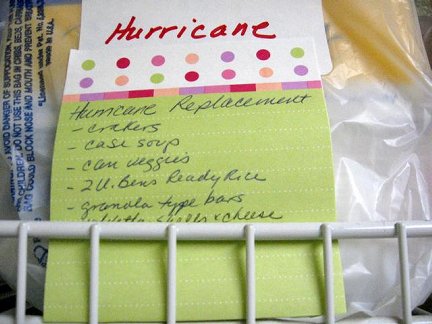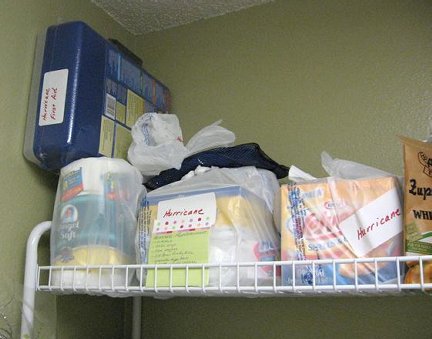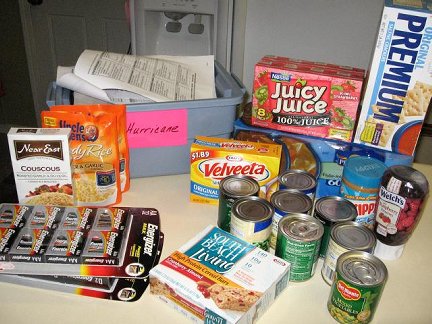Do not put off stocking up on food, water and supplies
Organizing for an Emergency Tomorrow – Cowering on the floor of my basement level guest room, I knew it was a sure sign that the tornado was near when, with a whoosh, the ceiling tiles all sucked up to the floor above. My ears popped just before they clattered back down, all off kilter, looking like building blocks kicked by a toddler.
Once the hail, howling winds, and driving rain passed, we ventured out to find our home still in tact. Like everyone in our town, we had suffered damages but fortunately our home stood in tact. Electricity was down. Communication was sketchy.
A few days later, I was the newspaper writer on the scene of the Red Cross kitchen. I followed along as their truck weaved between trees and debris to try to get food to people. I learned first hand what it means to have emergency food and water supplies in your home.
At the point that you are cowering on the floor of your home, piling sandbags against the doors, nailing plywood over your windows or waking up to three solid inches of ice and no sign of thaw, it is too late to take stock of your pantry.
I moved from tornado alley and today I live in a hurricane zone which took a major hit in 2004. Yes, we have tornados here too. Other parts of the country worry about earthquakes, flash flooding, fast moving fires, winter ice storms, or being trapped by deep snows. Indeed, everyone is susceptible to a power outage and should be organizing for an emergency!
What have you done in your pantry to prepare for an emergency? You cannot wait until you are in an emergency mode to think about what your family might need. Do not think that planning to evacuate in the event of crisis means that you will not need food. You may find in an emergency that the roads are clogged or blocked. Or you may find that the disaster is wide spread. Grocery stores can indeed be shut down, as the people of New Orleans will tell you.
Today’s calm is the perfect time to address emergency food preparations. Any time is a good time to get your supplies together. If you live in a hurricane prone area, you are entering peak hurricane season and need to take action. Here are some suggestions for getting you started:
The United States NOAA (the National Oceanic Atmospheric Administration) suggests we have at least one (1) gallon of water per person for 3 to 7 days and enough food to last for the same period of time.
Create a shopping list for food and water.
During an emergency, you will be under a lot of stress and good nutrition is important. Make sure to make a well-rounded list of fruits, vegetables, proteins, carbohydrates and beverages.
Consider the needs of babies, the elderly or anyone with special dietary concerns or allergies in your family.
Add paper plates, cups and plastic utensils to your list. Water for dish washing will be in short supply. You will also want paper towels, plastic wrap, plastic bags, foil and fuel, such as sterno, charcoal or propane.
Finding this list scary to your budget? Work on shopping gradually. Add a few items from your emergency supply list to each week’s grocery shopping until you’ve finished the list.
Store the food separately from your regular food. Otherwise, when the emergency arises, you may find the food you thought you had on hand has been eaten. I have tied mine up in grocery sacks and stacked them in a laundry room adjacent to the kitchen. I can use them here or, if I need to evacuate, they are already bagged and packed for me to quickly grab.
Write a note to yourself on your calendar for six months from now. At that time, check the expiration dates on your food and your water bottles. Replace as needed. Note it again on your calendar for six months into the future. Get in a habit of continuing this cycle.
Remove foods that will expire in the next six months from the emergency supplies and place them in the front of your pantry to be used soon. This way you will not waste any food or your funds.
For those in hurricane areas: December first, remove your food that will expire in the next six months. Create a shopping list of the items you must replace. Tape it to your emergency supplies. In June, you can easily restock for the new hurricane season by grabbing the list you created.

Favorite Food Emergency Ideas:
Crackers, Peanut Butter and Jelly or Honey – I choose crackers because bread has a short shelf life.
Coffee – If you need caffeine daily, you can bet you will doubly need it in a crisis. I like the individual packets of instant. Easy to store and you can use just one at a time. Do not forget powdered creamer and packets of sweetener.
Ready-to-eat Rice – These vacuum packages of rice require neither refrigeration nor water to prepare. You can make a whole meal by opening the package and stirring in some canned chicken, tuna or vegetables.
Couscous – Unlike pasta or rice, this grain only needs one cup of water to prepare. It does not even require a cooking time. Simply pour your cup of water over it, cover and let it sit five minutes. It saves on fuel and water.
Tuna, Chicken, Turkey – Canned meats or meats in a pouch can be eaten with the rice, couscous or on crackers.
Vegetables/Fruits – Small single-serving containers or cans are great as you won’t have refrigeration for leftovers.
Meal Replacement Bars – While you normally think of these as “diet bars,” these bars are a great product in an emergency kit. They have the nutrition and calories of a full meal but have a long shelf life and take up little space.
Juice Boxes – The kiddies’ staple of lunch boxes is a great way to get individual servings of juice that don’t need refrigeration. Make sure to check your juice content on the side label as you don’t want to end up with sugar water.
Canned Soup – Do not chose condensed soups, the kind that requires you to add water. Stock some cans of soup that are ready-to-eat. Even if you do not heat them, they can be open and eaten as is.
Powdered Milk – If milk is important to you, then buy a box of powdered milk. You can mix up just a glass at a time.
Mac and Cheese – For variety, you can an add macaroni and cheese kit to your supplies. Choose the type that comes with a packet of ready-to-use cheese sauce rather than the powdered type that calls for milk and butter.
Instant Dinners – Individual cups or packages of ready-to-eat meals such as spaghetti, ravioli and chicken and dumplings are easy to use.
Granola or Cereal Bars – Traditional breakfast of bacon and eggs or cold milk with cereal won’t be available. Granola or cereal bars and canned fruit can get you through the morning hours.
Nuts – Cans or jars of peanuts, almonds or mixed nuts offer high snacking nutrition without taking up much space.
 Author Lea Schneider, a columnist for What’s Cooking America, is a freelance writer and organizational expert whose organizing ideas have been published in many magazines including Woman’s Day, Better Homes and Gardens Kitchen and Bath Ideas, Family Circle, Parents Magazine, as well as numerous newspapers and websites. She is a member of the Association of Food Journalists.
Author Lea Schneider, a columnist for What’s Cooking America, is a freelance writer and organizational expert whose organizing ideas have been published in many magazines including Woman’s Day, Better Homes and Gardens Kitchen and Bath Ideas, Family Circle, Parents Magazine, as well as numerous newspapers and websites. She is a member of the Association of Food Journalists.
Getting organized is all about living simpler and making things easier. The bonus is it often leads to saving money. Lea Schneider’s kitchen organizing columns tell you how to organize the many things that relate to kitchens, menus, meals, and special food events.
Check out all of Lea Schneider’s helpful home and kitchen columns at Organizing Kitchens, Pantries, Menus and Meals.
Categories:
Kitchen Organization

